Marbling and paste papers are interesting and beautiful ways to experiment with color and pattern on paper for bookmaking, postcards and textures for drawings or paintings. These are processes hundreds of years old that were used in decorating end pages in books.
Cornstarch paste Papers1
Cornstarch paste paper recipes give a matte finish to your papers. I found it to be thicker than the rice formula. It spreads easily and you can use tools like combs, sticks and string to make patterns. You use it directly on the paper.
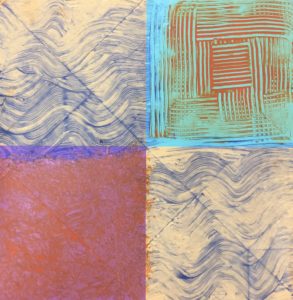
On origami paper
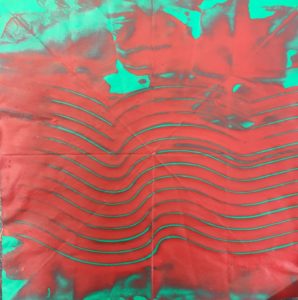
Cornstarch Paste Recipe:
1/4 c. cornstarch
1 + 3/4 c. water
- mix cornstarch with water on med. heat
- stir until it resembles thick custard
- remove from heat and add 1/2 c. water
- mix once then cool
methyl cellulose Papers (i.e. elmer’s paste powder)
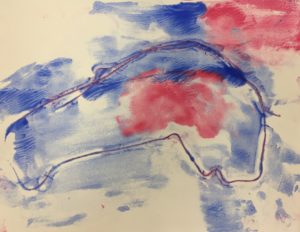
Use it like painting–directly on paper
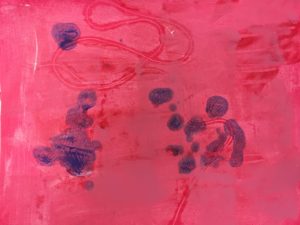
Gives a nice texture for drawing
Rice Paste Recipe:
(NOTE: Methyl cellulose mixes (store-bought) or cornstarch recipes are less reactive to people with gluten allergies, as this recipe has wheat.)
4 T rice flour
3 T wheat flour
3 c. water
1/2 tsp. glycerin
1 T dish washing detergent
- over medium heat, thicken paste
- cool in fridge (it’s good when it resembles pudding)
- mix 2 T acrylic paint with 1 c. paste
Prang Ambrite pastel Papers
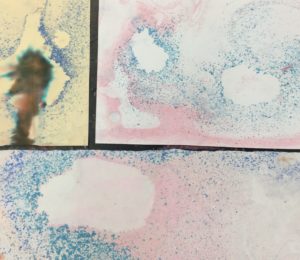 Prang Ambrite pastels shaved into water make a nice diffusion. I used dish detergent on a brush to disperse the color. It made it separate, but gives a splattered effect and a hole.
Prang Ambrite pastels shaved into water make a nice diffusion. I used dish detergent on a brush to disperse the color. It made it separate, but gives a splattered effect and a hole.
SuminagaShi Papers
Suminagashi is a Japanese form of paper marbling and is a very old process originating in China over 2000 years and refined by Japanese Shinto priests in the 12th century. Inks or paint are floated on the surface of the water, alternating one brush loaded with pigment and the other with dish soap as a dispersant.2 Paper is then laid over the surface of the water, gently pressing down and then pulling it up and off.
Turkish Marbling Papers
Turkish marbling is made by placing colors like Jacquard paints on the surface of a water and carrageenan mixture, then pulling a print of it with a paper sized with a mordant like alum. The colors are the brightest of the processes we experimented with. This process started in the 15th century in Persia and Turkey.3
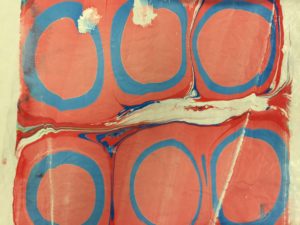
On fabric
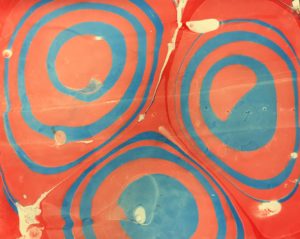
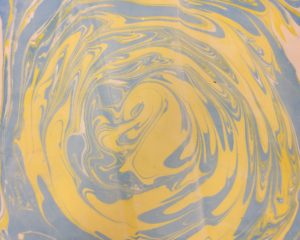

Shaving Cream Papers

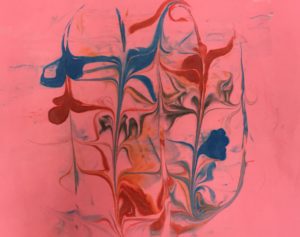
These were made by applying shaving cream on a plate, putting food coloring on top and then pulling a print. You can mix them around with various tools like skewering sticks and combs.
1 Wooding, C. (2018). Paste paper recipe. My paper arts. Retrieved from http://www.mypaperarts.com/tag/paste-paper-recipe.
2 History of Suminagashi and Marbling. (2018). Suminagashi: The ancient art of Japanese marbling. Retrieved from http://suminagashi.com/overview.
3 History of Suminagashi and Marbling. (2018). Suminagashi: The ancient art of Japanese marbling. Retrieved from http://suminagashi.com/overview.


